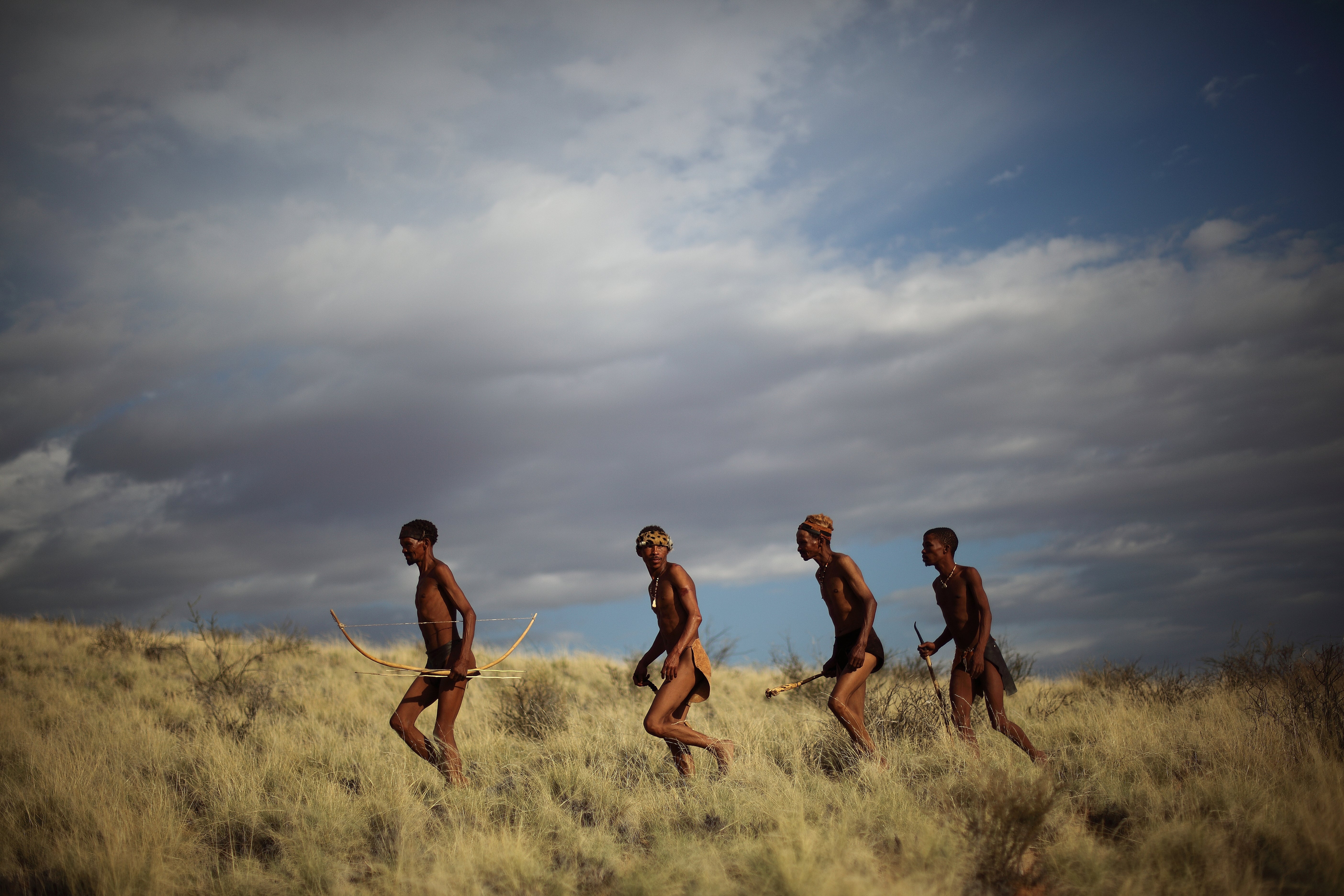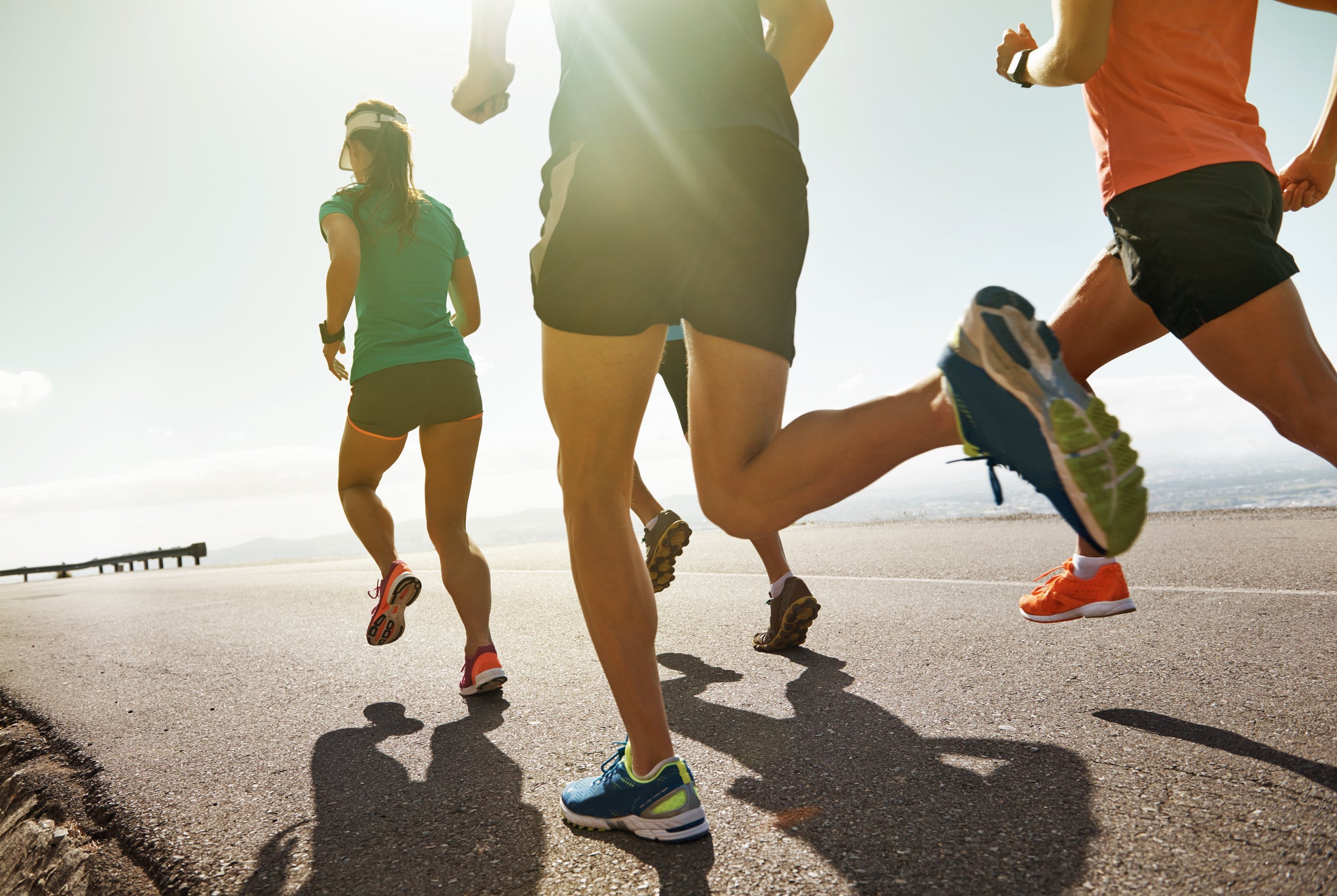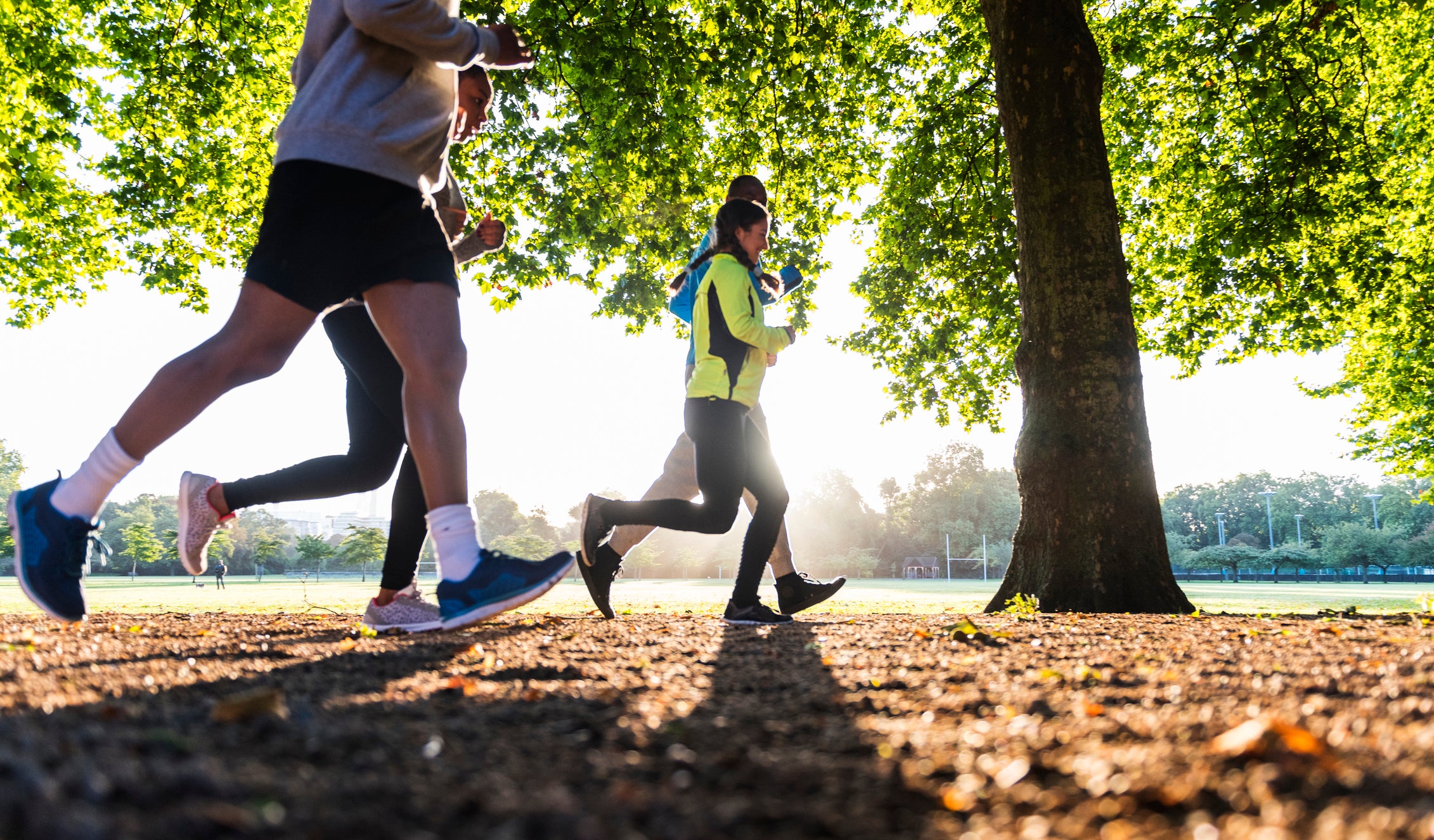Is the ‘runner’s high’ proof humans were born to run?
If the good feeling that comes from exercising is a biological reward for hunting long enough to find food, can retracing our palaeolithic past lead to a happier, healthier future? asks Sean T Smith


Homo sapiens came of age sweeping through the east African plains, foraging for food, fighting for survival and trying to hunt prey. But so-called progress stalled their momentum and reduced life to an unnatural standstill when our ancestors settled down during the agricultural revolution 12,000 years ago.
Given that we have spent just 600 generations putting down roots, and the previous 99 per cent of our history hunting and gathering, it’s not surprising that our bodies and brains remain Palaeolithic. Setting that timescale in an evolutionary context not only makes civilisation seem like a phase – and farming just a fad – but also explains why so many of our health problems stem from being so maladapted to modernity.
Evolutionary biologists have long believed that major modern killers like heart disease, osteoporosis, obesity and some types of cancer would have been lower in the palaeolithic era when rates of exercise must have been so much higher than today.
And ever since an influential 2006 anthropological study found that surviving groups of modern hunter-gatherers possessed exceptional mental health, researchers have speculated that depression rates may have been much lower too. Many neuroscientists now believe that the so-called “runner’s high” we experience after bouts of prolonged and intense physical exercise is an evolutionary echo of our hunter-gatherer past and might explain why exercise is so closely correlated with good mental health.
The theory aligns with the increasingly influential “running made us human” hypothesis, popularised by biologists Daniel Lieberman and Dennis Bramble in 2004. Their extraordinary study found that fossil remains of our early hominin ancestors from around 2 million years ago, already bore adaptations suggesting that evolution had engineered us to be long-distance, persistence hunters. Put simply, we were born to run.

Early hominins already had short toes, a narrow pelvis, robust joints and crucially an expanded attachment for the gluteus maximus. Our unusually prominent buttocks had previously been regarded as an adaptation for walking upright. But in an experiment using wired-up volunteers, Lieberman was able to show that walking barely involves the gluteus maximus – but without it running would be impossible.
The “running made us human” hypothesis also explains why early humans were already effective hunters long before the development of nets or projectile weapons like spears or arrows: instead, our endurance athlete ancestors chased their prey to exhaustion.
With our furless bodies and wealth of sweat glands that discharged heat while simultaneously cooling us as we ran, we were engineered to outlast most mammals in pursuits over many miles of African savannah.
If surviving groups of hunter-gatherers, like the Kalahari Bushmen, are a reliable guide to the prehistoric work-life balance it’s likely that our ancestors would have walked or run for around two hours per day covering around 6-9 miles before returning to camp and enjoying far more leisure time than we do.
Everyone used to say: go get your endorphins in the morning. Over the last decade or so there’s been some research questioning the role of endorphins as the main player in the runner’s high
Evidently, hunter-gatherers also seem to be accomplished loafers – and avoiding unnecessary exercise is likely to be an ancient instinct. After all, in an environment where food is scarce, conserving energy might just keep you alive.
It’s unlikely that our ancestors ever ran without a reason. Running was work but it came with job satisfaction biologically built in – that blissful feeling of elation that comes with exercise. Some paleoanthropologists believe that “the runner’s high” was hardwired into our ancestors by evolution as a “neurobiological reward” for keeping going long enough to find food.
Until recently, the runner’s high had been attributed to endorphins, a natural opiate activated whenever we exercise, but Hilary A Marusak, assistant professor of psychiatry and behavioural neurosciences at the Wayne State University School of Medicine in Michigan explains to me that this is almost certainly not the case. Now the evidence suggests that the sense of blissful well-being is caused by endocannabinoids, tiny molecules made of lipids – or fats – which are generated by the body whenever we exercise. Endocannabinoids contain similar psychoactive compounds to those found in cannabis.
“I’m a runner,” she says. “Everyone used to say: go get your endorphins in the morning. Over the last decade or so there’s been some research questioning the role of endorphins as the main player in the runner’s high. Endorphins are really big molecules that do not easily penetrate the blood-brain barrier. In contrast, endocannabinoids are lipid or fatty molecules. They love brain tissue and very easily pass through that protective layer.”

Dr Maruzak explains that studies have shown that athletes still experience elation when the effects of opioids like endorphins have been blocked. But when you block endocannabinoids, there is no runners’ high effect and those findings have been replicated across human and animal studies.
In a meta-analysis of 33 published studies on the impact of exercise on endocannabinoid levels, her research team found that acute exercise – jogging or cycling for 30 minutes for example – consistently boosted endocannabinoid levels most notably anandamide – the so-called “bliss molecule”. Maruzak is inclined to agree with the “running made us human” hypothesis.
“The endocannabinoid system is as old as our nervous system so it’s been around for a very long time – it does make sense that we have these hardwired circuits that modify our behaviour and these reward systems that are overlapping,’’ she says.
David Raichlen is a professor of evolutionary biology at the University of Southern California. Raichlen argues that if the persistence-hunting hypothesis were true, we would see the same reward pattern occurring in other animals that hunt over distances.
In 2012, Raichlen’s team found that in both humans and dogs there was a significant increase in eCB signalling following high-intensity exercise. Ferrets, on the other hand, showed no such increase. This, Raichlen argues, explains why hunting animals instinctively engage in aerobic activities while non-hunters do not.
As our ancestors ran, their heightened state of alertness was aided by short, sharp bursts of adrenalin and cortisol the so-called stress hormones that put us into fight or flight mode.

Dr Mazurak explains that after exercise, the raised levels of endocannabinoids are key to dialling down stress hormones and quickly restoring balance in the brain and body in a process called homeostasis.
Maintaining homeostasis is now believed to be the primary role of the endocannabinoid system and which is believed to control sleep, temperature control, immune responses, appetite, libido, memory formation and mood.
Experts believe that frequent exercisers develop self-regulatory systems that restore those physiological systems to their natural optimal settings far more efficiently than in people who are not as physically active.
In terms of mental health, it’s believed that exercise helps us become much better at reacting to external or emotional stressors by creating more endocannabinoid receptors which help keep pain and anxiety at bay.
For our ancestors, running long distances in pursuit of prey was a beneficial external stressor that was rewarded by feelings of elation and quick restoration of optimal settings by the endocannabinoid system. But for their desk-bound descendants in claustrophobic offices, fretting over deadlines, stress is emotional and prolonged with little means of mitigation.

The stress hormones that were so beneficial to our ancestors in extremis are potentially harmful in the workplace because the constraints that keep us from moving also keep the hormones at toxically high levels throughout the day inducing brain fog, fatigue and dips in motivation.
Exposure to long-term stress can be toxic to the body, even leading to medical concerns like high blood pressure and a weakened immune system. It’s why stress is such an occupational hazard and sometimes a precursor to anxiety and depression.
The idea that if exercise were a drug, it would be the most valuable pharmaceutical ever developed has become so axiomatic in modern medicine that exercise is now the go-to stress buster as well as a guardian of our cardiovascular health.
But if you wanted to replicate and emulate the rhythms of our hunter-gatherer ancestors’ lifestyle, reaching for the running shoes would only be a start
But from a neuroscientific point of view, Dr Maruzak explains that the effects of exercise are so widespread and complex that we’re only just beginning to understand them.
“The endocannabinoid system is new to modern medicine,” she says, “we’ve only discovered it in the last 50 years; it’s a very old evolutionary system but we’re learning new things about it every day.”
Instead of characterising exercise as a drug, she thinks it would be more accurate to think of it as our source of equilibrium because of its role in homeostasis. Without it, things start to go awry.
So perhaps it’s not surprising that the functioning of our brains and bodies have become inextricably linked and that everything about our physiology – especially our ability to think – works better shortly after we’ve been moving. It’s why we remain “cognitively engaged endurance athletes” to use the expression coined by Prof Raichlen.
Perhaps this was better understood in antiquity by peripatetic Greek philosophers like Aristotle and Plato who walked while teaching students because they believed moving promoted clearer thinking.

But the idea that unhappiness might not be an inevitable part of the human condition but a by-product of being genetically mismatched to our modern environment would be revolutionary for modern medicine and philosophy alike.
Evidence to support such a hypothesis is not going to be unearthed in the fossil record by a paleoanthropologist. If that discovery is to be made anywhere it will probably be in a neuroscience lab like that run by Dr Marusak. Her team studies the complex role of the endocannabinoid system in stress regulation and anxiety disorders in children and adolescents.
In the meantime the idea that the happiest human who ever drew breath may have lived on the African savannah tens of thousands of years ago is intriguing.
But if you wanted to replicate and emulate the rhythms of our hunter-gatherer ancestors’ lifestyle, reaching for the running shoes would only be a start. Joining a running club would be an even better idea: studies have shown that exercising in sync with others causes endocannabinoids to really surge.
But perhaps the secret to their success was the close-knit bonds of affection forged while they hunted in pursuit of a common goal. And then sharing the spoils over a communal meal, with plenty of time afterwards to sit around gossiping. Perhaps they rounded off the evening by singing and dancing – two activities that have also been shown to boost bliss chemicals in the brain.
Although a modern equivalent of that fulfilled, purposeful collegiate lifestyle might be difficult for most of us to replicate in the workplace today, perhaps we can take heart from the fact that persistence has been hardwired into our DNA and that for us, life has always been more of a marathon than a sprint.




Join our commenting forum
Join thought-provoking conversations, follow other Independent readers and see their replies
Comments